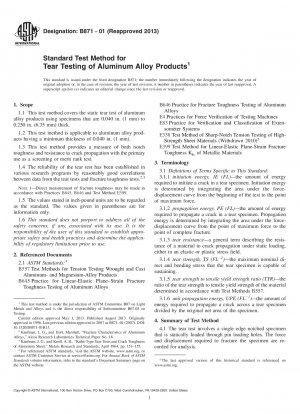ASTM B871-01(2013)
Standard Test Method for Tear Testing of Aluminum Alloy Products
- Standard No.
- ASTM B871-01(2013)
- Release Date
- 2001
- Published By
- American Society for Testing and Materials (ASTM)
- Latest
- ASTM B871-01(2013)
- Scope
5.1 The significance of the tear test is similar to that of the notch-tensile test, and its primary usefulness is as an indicator of toughness or as a ranking test as described in Test Method E338 and Practice B646.
5.1.1 This test method provides a comparative measure of resistance of aluminum alloys and products to unstable fracture originating from the presence of crack-like stress concentrators. This test method is not intended to provide an absolute measure of resistance to crack propagation that might be used in the design of a structure.
5.2 Values of the energies required to initiate and propagate cracks in tear specimens are determined by measuring or integrating the appropriate areas under the test curve developed during the test.
5.3 The unit propagation energy (UPE) is the primary result of the tear test. This value provides a measure of the combination of strength and ductility that permits a material to resist crack growth under either elastic or plastic stresses. The UPE value normally will exhibit greater scatter than conventional tensile or yield strength values. In order to establish a reasonable estimate of average properties, it is recommended that replicate specimens be tested for each metal condition being evaluated. The UPE value has significance as a relative index of fracture toughness.
5.4 The ratio of the tear strength to the tensile yield strength is a measure of notch toughness comparable to the notch-yield ratio from notch-tensile tests carried out in accordance with Test Method E338. It is of value in relative ranking of materials with regard to their toughness.2,3
5.5 The numerical results of the test are dependent upon the specimen size and geometry, although specimen thicknesses over the range of 0.063 in. (1.6 mm) to 0.100 in. (2.5 mm) have not shown a significant effect on tear strength (TS) and unit propagation energy (UPE).6 These values may exhibit a dependency to thickness when the specimen thickness is outside of this stated range and care shall be taken when using this data.
5.6 The tear test can serve the following purposes:
5.6.1 In the research and development of materials, to study the effects of variables of composition, processing, heat treatment, etc.
5.6.2 In service evaluation, to compare the relative crack propagation resistance of a number of aluminum alloys or products that are otherwise equally suitable for an application.
5.6.3 For specifications of material acceptance and manufacturing quality control when there is a sound basis for establishing a minimum acceptable t......
ASTM B871-01(2013) Referenced Document
- ASTM B557 Standard Test Methods of Tension Testing Wrought and Cast Aluminum- and Magnesium-Alloy Products
- ASTM B645 Standard Practice for Plane-Strain Fracture Toughness Testing of Aluminum Alloys
- ASTM B646 Standard Practice for Fracture Toughness Testing of Aluminum Alloys
- ASTM E338 Standard Test Method of Sharp-Notch Tension Testing of High-Strength Sheet Materials
- ASTM E399 Standard Test Method for Plane-Strain Fracture Toughness of Metallic Materials
- ASTM E4 Standard Practices for Force Verification of Testing Machines
- ASTM E83 Standard Practice for Verification and Classification of Extensometer
ASTM B871-01(2013) history
- 2001 ASTM B871-01(2013) Standard Test Method for Tear Testing of Aluminum Alloy Products
- 2001 ASTM B871-01(2007) Standard Test Method for Tear Testing of Aluminum Alloy Products
- 2001 ASTM B871-01 Standard Test Method for Tear Testing of Aluminum Alloy Products
- 1996 ASTM B871-96 Standard Test Method for Tear Testing of Aluminum Alloy Products

Copyright ©2024 All Rights Reserved